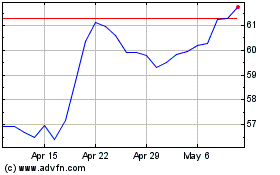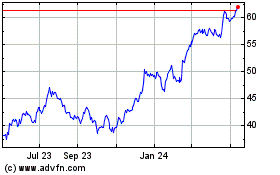- U.S. investor optimism steady at
7-year high in second quarter
- Seven in 10 say online investing
tools are important, but few would use them exclusively
U.S. investor confidence was steady in the second quarter of
2015 at a seven-year high point, with the Wells Fargo/Gallup
Investor and Retirement Optimism Index registering +70 in May,
similar to +69 in February. And for the second straight quarter,
confidence is about the same among retired (+67) and non-retired
(+70) investors. The survey of 1,005 U.S. investors was conducted
May 22 through May 31, 2015. The median age of the retiree is 68
and the non-retiree is 45.
This Smart News Release features multimedia.
View the full release here:
http://www.businesswire.com/news/home/20150623005281/en/
Americans Still Confident in “The American Dream”
Confidence in the American Dream remains solid. Eighty-four
percent of investors are as confident today as they were a year ago
that the American Dream is achievable for them. And the way they
define that dream is consistent; nearly all investors – 96% – agree
that living comfortably in retirement is a part of their American
Dream, up from 92% last year. More than nine in 10 also say their
American Dream means affording their own home (93%) and having
meaningful employment (92%). Having the world be a better place to
live is part of the American Dream for 81% of investors, while
having a standard of living that surpasses that of their parents
ranks last of the five concepts measured, at 77%.
Investors Fall Short on Having a Written Financial
Plan
Over two-thirds (69%) of non-retired investors say they have a
specific financial plan to reach their retirement and investment
goals, of which about half of these, or 36% of all non-retired
investors, say it is a written plan. While that figure has been
steady since 2013, it is up from early 2011 when less than a
quarter of non-retired investors had a written plan. Additionally,
74% of non-retirees with a written financial plan – up from 66% in
2011 –say they developed it with the help of an investment advisor.
Retired investors are only a bit more diligent about financial
planning, with 73% saying they have a plan, and 43% having a
written plan. Retired investors are more likely to say they stick
very closely to what’s in their plan, 63% vs. 48% of the
non-retired.
The majority of investors (94% of retirees/89% non-retirees) are
highly or somewhat confident that their written financial plan is
adequately designed to ensure they will reach their financial
goals.
“While the number of people with written plans is slowly
trending higher, it’s still less than half of investors. It is
critical to have a financial plan in place that spans life’s major
milestones in order to reach your financial goals,” said Mary
Mack, President of Wells Fargo Advisors. “One of the most
important things that our financial advisors do for our clients is
to help them translate their financial goals into tangible, written
plans that provide the basis for professional advice on every
aspect of their finances and individually designed investment
portfolios that can help families achieve their life aspirations,”
said Mack.
Online Investing Tools Appeal, but Most Won’t Rely on Them
Exclusively
Investors said access to online or digital investing tools is
about as important to them as having a strong relationship with a
personal financial advisor. When asked about different ways to get
financial advice, 71% of investors say that having access to online
or digital investing tools is very or somewhat important to them,
roughly matching the 70% who say the same about having a strong
relationship with a personal financial advisor. That is followed by
having on-call access to financial advisors (64%) and having a
trusted friend or family member to provide advice (55%).
However, when asked which of the three professional resources is
most important to them, having a strong relationship with a
personal financial advisor ranked highest (50%), followed by having
access to state of the art online or digital investing tools (24%)
and on-call access to a financial advisor (19%).
Interestingly, a majority of investors do not feel confident
about investing in the market on their own, with 78% saying they
prefer consulting with someone for professional advice. And seven
out of ten investors (71%) say it is critical or very important to
seek professional advice when creating a long-term financial
plan.
When asked about their ideal financial advice experience, most
investors would prefer to have a blended approach, involving both a
personal relationship and digital advice. The largest share, 39%,
want the experience to be mostly with a financial advisor, but with
an online or digital component. Next, 26% want a mostly digital
experience but with access to a financial advisor. Slightly fewer,
23%, want their financial advice entirely from a financial advisor
while just 9% want it entirely online or digital.
“Technology is constantly evolving and changing how investors
want to interact with their financial services firm. Through this
data, investors are telling us they truly value a personal
relationship with an advisor, who also uses technology in a
collaborative way,” said Mack.
Financial Worries of Investors
Of five prominent risks, investors are most concerned about
personal identity theft, with 57% saying they worry a lot or a fair
amount about it, followed by cyber-attacks on their savings or
investment accounts, at 47%. About four in 10 are worried about
stock market volatility (42%) as well as investment scams or frauds
(41%), and 32% are worried about financial abuse or exploitation of
older family members or close friends.
While elder financial abuse trails other risks, one-third of
investors (32%) say they know someone who has been the victim of
investment scams or financial abuse targeted at the elderly. Almost
half of investors (47%) are very or somewhat likely to rely on a
personal financial advisor to protect them or a family member from
elder abuse in the future.
“Over the past three years, we’ve been seeing reports of such
abuse coming in from our advisors and unfortunately, we expect to
see that growth continue as our population ages. Financial firms
must take an active role in raising awareness and preventing elder
fraud and financial abuse, including expanded training and guidance
for clients,” said Mack.
About the Wells Fargo/Gallup Investor and Retirement Optimism
Index
These findings are part of the Wells Fargo/Gallup Investor and
Retirement Optimism Index, which was conducted May 22-31, 2015, by
telephone. The Index includes 1,005 investors randomly selected
from across the country with a margin of sampling error of +/- four
percentage points. For this study, the American investor is defined
as an adult in a household with total savings and investments of
$10,000 or more. About two in five American households have at
least $10,000 in savings and investments. The sample size is
comprised of 72% non-retired investors and 28% retired investors.
Of total respondents, 59% had reported annual income of less than
$90,000 and 41% of $90,000 or more. The Wells Fargo/Gallup Investor
and Retirement Index is an enhanced version of Gallup’s Index of
Investor Optimism that provides its historical data. The median age
of the non-retired investor is 45 and the retiree is 68.
The Index had a baseline score of 124 when it was established in
October 1996. It peaked at 178 in January 2000, at the height of
the dot-com boom, and hit a low of negative 64 in February
2009.
Note: Complete survey results and a chart showing the
index movement are available upon request.
About Wells Fargo & Company
Wells Fargo & Company (NYSE:WFC) is a nationwide,
diversified, community-based financial services company with $1.7
trillion in assets. Founded in 1852 and headquartered in San
Francisco, Wells Fargo provides banking, insurance, investments,
mortgage, and consumer and commercial finance through more than
8,700 locations, 12,500 ATMs, and the internet (wellsfargo.com) and
mobile banking, and has offices in 36 countries to support
customers who conduct business in the global economy. With
approximately 266,000 team members, Wells Fargo serves one in three
households in the United States. Wells Fargo & Company was
ranked No. 30 on Fortune’s 2015 rankings of America’s largest
corporations. Wells Fargo’s vision is to satisfy all our customers’
financial needs and help them succeed financially. Wells Fargo
perspectives are also available at Wells Fargo Blogs and Wells
Fargo Stories.
About Gallup
For more than 70 years, Gallup has been a recognized leader in
the measurement and analysis of people’s attitudes, opinions, and
behavior. While best known for the Gallup Poll, founded in 1935,
Gallup’s current activities consist largely of providing marketing
and management research, advisory services and education to the
world’s largest corporations and institutions.
INVESTMENT AND INSURANCE PRODUCTS: NOT FDIC INSURED | NO BANK
GUARANTEE | MAY LOSE VALUE
Wells Fargo Advisors is the trade name used by two separate
registered broker-dealers: Wells Fargo Advisors, LLC and Wells
Fargo Advisors Financial Network, LLC, Members SIPC, non-bank
affiliates of Wells Fargo & Company.
CAR# - 0615-03438
View source
version on businesswire.com: http://www.businesswire.com/news/home/20150623005281/en/
Wells Fargo & CompanyAllison Chin-Leong, 212-214-6674
(Media)allison.chin-leong@wellsfargoadvisors.com
Wells Fargo (NYSE:WFC)
Historical Stock Chart
From Mar 2024 to Apr 2024

Wells Fargo (NYSE:WFC)
Historical Stock Chart
From Apr 2023 to Apr 2024
